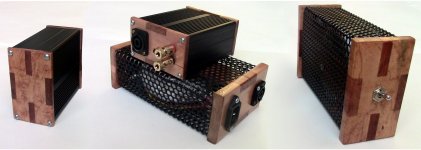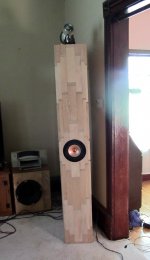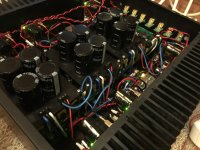Sorry, I don't understand.
What is the bandwidth for the specified SNR 110dB relative to the full power of FO-M v1.4?
Just asking, because this number will be different for @22kHz, @44kHz, @80kHz or @500kHz.
Thanks.
What is the bandwidth for the specified SNR 110dB relative to the full power of FO-M v1.4?
Just asking, because this number will be different for @22kHz, @44kHz, @80kHz or @500kHz.
Thanks.
Front & back plates finally assembled
Some more pics for those interested in Black Mamba chassis. WYSIWYG 😉
Some more pics for those interested in Black Mamba chassis. WYSIWYG 😉
Attachments
-
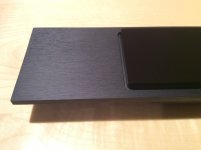 IMG_0714.jpg344.5 KB · Views: 642
IMG_0714.jpg344.5 KB · Views: 642 -
 IMG_0712.JPG794.1 KB · Views: 630
IMG_0712.JPG794.1 KB · Views: 630 -
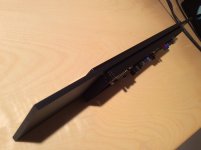 IMG_0711.JPG766.4 KB · Views: 577
IMG_0711.JPG766.4 KB · Views: 577 -
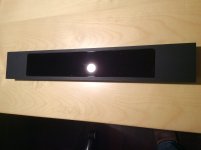 IMG_0715.JPG914.2 KB · Views: 564
IMG_0715.JPG914.2 KB · Views: 564 -
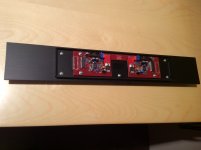 IMG_0716.JPG923 KB · Views: 570
IMG_0716.JPG923 KB · Views: 570 -
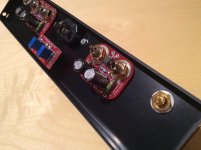 IMG_0720.jpg376.8 KB · Views: 273
IMG_0720.jpg376.8 KB · Views: 273 -
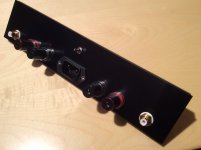 IMG_0721.JPG953.1 KB · Views: 244
IMG_0721.JPG953.1 KB · Views: 244 -
 IMG_0722.JPG913 KB · Views: 264
IMG_0722.JPG913 KB · Views: 264 -
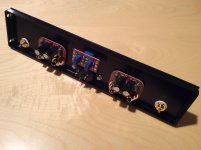 IMG_0717.jpg316.7 KB · Views: 274
IMG_0717.jpg316.7 KB · Views: 274 -
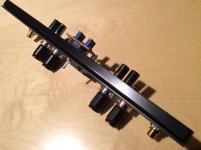 IMG_0723.jpg337.2 KB · Views: 221
IMG_0723.jpg337.2 KB · Views: 221
Any progress with this comparison? Would be very useful to many of us!Have to adjust bias on my F 5 V 3 turbo. It is not an easy task.
Any progress with this comparison? Would be very useful to many of us!
He's at this phase making four channel amp, two channel amp went to his friend.
Have some problems with the F 5. Waiting for new Jfets because I think they maybe are fake. Bought new pots for it as well. In the position it was almost unpossible to adjust. Later this week maybe the four channel and the F 5 is finnished.
Last edited:
At some week here, this kit will be playing some music!
Any progress?

First impressions
Yes sir 😀
I actually got the amp fully assembled last Tuesday morning at 4 a.m. I even figured out the molex connectors with the last two on hand and an hour of searching for the other two that flew across my studio. I will get into that when I post the photos.
I had a 70 hour work week last week, so I got a song or movie clip in each night. Had a little more time this last weekend. What I can say so far is this is a significant upgrade for me. 🙂 All win, win, with no compromises.
Two things that stood out for me on both speaker systems I have is:
1 - the abundant amount of tonal texture.
2 - how this amp holds it together on complex listening material.
I am not necessarily hearing any new sounds, as much as, I am hearing more into the sound already there. The best way to describe it, is thru my Chip Amps, I heard simple colored forms, now with First One, they have a finite shape, texture, and gradation of color. Reminds me when I upgraded to 1080 HD video from 480 SD, this being the sound equivalent. But it goes deeper then that. The Chip Amps seems to have a lot of "something" in the way, preventing them from revealing the vivid tonal landscape First One is capable of. I am sure this is no surprise to many of You 😉
The two speaker systems I have are a cheap experimental line array system, I call "cheap and cheerful", and a single driver rear horn system, designed by Woden Design, called Avebury. My arrays have 15 NSF drivers per cabinet, and the Avebury uses Planet 10's EnAbled Mark Audio's flagship driver: Alpair 12. Two extremes to say the least. I love the tone of the Alpair and the presentation of the arrays, so big compromises happening here. But I do get more out of each system with First One. And I feel pretty confident moving on to my next speaker build with First One.
What I can comment on now is how First One handles the Avebury design. Avebury is a tough speaker to drive, esp at louder levels, being both full-range and horn loaded. I was getting a lot of IM distortion before. I was not sure if this was a physical limitation of the driver and design, as it is a lot to ask ONE driver to play from 40 Hz to 20 kHz. I am happy to report that First One IS up to the task! 😀 Very impressive indeed. It takes charge of the Alpair 12 and lets this system reach its full potential. I good match for sure.
I am sorry I do not have any Nelson Pass designs or "known" speaker designs to offer comparisons for some of You prospects out there. But what I can say, is that it cost me about $300 to build my Chip Amps. The First One came to about $900. Is it worth three times more? For sure - Yes! Over 17 years ago, I had a McIntosh MC-150, that was $2500 back then. Sold it for the down payment on the house I have now. Even though I do not have a direct comparison, the First One reminds me more of that McIntosh amp, then say my $1000 Pioneer DS-1 AVR that died four years ago.
I feel like a got a $2000+ amp for $900. 😀
I have a lot of listening and tweaking to do still. I am thinking this amp can dig pretty deep.
Allen 😉
Any progress?
Yes sir 😀
I actually got the amp fully assembled last Tuesday morning at 4 a.m. I even figured out the molex connectors with the last two on hand and an hour of searching for the other two that flew across my studio. I will get into that when I post the photos.
I had a 70 hour work week last week, so I got a song or movie clip in each night. Had a little more time this last weekend. What I can say so far is this is a significant upgrade for me. 🙂 All win, win, with no compromises.
Two things that stood out for me on both speaker systems I have is:
1 - the abundant amount of tonal texture.
2 - how this amp holds it together on complex listening material.
I am not necessarily hearing any new sounds, as much as, I am hearing more into the sound already there. The best way to describe it, is thru my Chip Amps, I heard simple colored forms, now with First One, they have a finite shape, texture, and gradation of color. Reminds me when I upgraded to 1080 HD video from 480 SD, this being the sound equivalent. But it goes deeper then that. The Chip Amps seems to have a lot of "something" in the way, preventing them from revealing the vivid tonal landscape First One is capable of. I am sure this is no surprise to many of You 😉
The two speaker systems I have are a cheap experimental line array system, I call "cheap and cheerful", and a single driver rear horn system, designed by Woden Design, called Avebury. My arrays have 15 NSF drivers per cabinet, and the Avebury uses Planet 10's EnAbled Mark Audio's flagship driver: Alpair 12. Two extremes to say the least. I love the tone of the Alpair and the presentation of the arrays, so big compromises happening here. But I do get more out of each system with First One. And I feel pretty confident moving on to my next speaker build with First One.
What I can comment on now is how First One handles the Avebury design. Avebury is a tough speaker to drive, esp at louder levels, being both full-range and horn loaded. I was getting a lot of IM distortion before. I was not sure if this was a physical limitation of the driver and design, as it is a lot to ask ONE driver to play from 40 Hz to 20 kHz. I am happy to report that First One IS up to the task! 😀 Very impressive indeed. It takes charge of the Alpair 12 and lets this system reach its full potential. I good match for sure.
I am sorry I do not have any Nelson Pass designs or "known" speaker designs to offer comparisons for some of You prospects out there. But what I can say, is that it cost me about $300 to build my Chip Amps. The First One came to about $900. Is it worth three times more? For sure - Yes! Over 17 years ago, I had a McIntosh MC-150, that was $2500 back then. Sold it for the down payment on the house I have now. Even though I do not have a direct comparison, the First One reminds me more of that McIntosh amp, then say my $1000 Pioneer DS-1 AVR that died four years ago.
I feel like a got a $2000+ amp for $900. 😀
I have a lot of listening and tweaking to do still. I am thinking this amp can dig pretty deep.
Allen 😉
Last Night I installed some pure silver Wire on FO1.4 Input and Sound is getting better and better. More clean detailed Sound ,which I already thought I got .
Regards DT
Regards DT
Allen,
Nice review.
Can you expand on what you meant by "IM distortion" in the post above? Can you also describe your chip amp build due to the great variety of chip amp designs out there? Which kit or schematic/chip you used?
Thanks,
Anand.
Nice review.
Can you expand on what you meant by "IM distortion" in the post above? Can you also describe your chip amp build due to the great variety of chip amp designs out there? Which kit or schematic/chip you used?
Thanks,
Anand.
Allen,
Thanks for the detailed review. And good to know that you are enjoying the music... that's what matters at the end of the day.
LC, sounds like another happy customer. 😀
Thanks for the detailed review. And good to know that you are enjoying the music... that's what matters at the end of the day.
LC, sounds like another happy customer. 😀
A keeper for sure!
Glad I figured out the Molex connectors so I can do this down the road. 😉
The Chip Amp build is Peter Daniel's (AudioSector) LM3875, the "classic" kit. The linear power supply was built according to the kit's instructions. As You can see from the photo below, is that I make it pretty hard to tweak components, as I made the chassis pretty small. 😱 I felt blessed that I got it all together! But to put the sound of this LM3875 kit into perspective, I liked them more then the Pioneer DS-1 AVR I mentioned above (which was their flagship in 1991). The Pioneer had more power but the LM3875 had a more "open" and 3 dimensional sound... ...With the First One, I get the best of both worlds, plus more. I now know what the reviewers mean by "space around the instruments" and "black background".
Yes, I should clarify what I meant by "IM distortion". When I would play Avebury at moderately loud levels with the LM3875, The bass would drown out the highs in a modulating fashion. Even at moderate levels, esp with trance music and certain movies, the bass would "mask out" the highs. At first I thought some of this was due to the streaming bit-rate, mp3, data compression and the such (as I do stream a lot here). Odd thing, is my "Cheap and Cheerful" line arrays and Pioneer CS-905s did not do that, they just sounded "distorted" (usual clicks, pops and grain) when pushed beyond the 40 watt capacity of LM3875. I was getting worried that the Avebury had a design flaw! It was really disheartening, as I put a lot of passion into that build, and for how big the system is, such a flaw would be unacceptable. But, as it turns out, the LM3875 was not the best match for this system, and its distortion signature was different. The two together Inter-Modulated! 😱 But with the First One, all such distortion is gone! 😎 And I think this goes farther then just having a bunch of watts. There is something to the First One design in how the power is put out. It can move those watts so fast and smoothly, it is like there are watts in-between the watts, like there is more "air" around the instruments! 😀
Yes, very happy indeed! I consider this amp a "reference" amp, and that is almost understating it, as this amp does what it does with so much finesse. I think Lazy is right, none of us really know what we have our hands on!
Analog DAC sounds intriguing. Is there a multi-channel version?
Last Night I installed some pure silver Wire on FO1.4 Input and Sound is getting better and better.
Glad I figured out the Molex connectors so I can do this down the road. 😉
Can you expand on what you meant by "IM distortion" in the post above? Can you also describe your chip amp build due to the great variety of chip amp designs out there? Which kit or schematic/chip you used?
The Chip Amp build is Peter Daniel's (AudioSector) LM3875, the "classic" kit. The linear power supply was built according to the kit's instructions. As You can see from the photo below, is that I make it pretty hard to tweak components, as I made the chassis pretty small. 😱 I felt blessed that I got it all together! But to put the sound of this LM3875 kit into perspective, I liked them more then the Pioneer DS-1 AVR I mentioned above (which was their flagship in 1991). The Pioneer had more power but the LM3875 had a more "open" and 3 dimensional sound... ...With the First One, I get the best of both worlds, plus more. I now know what the reviewers mean by "space around the instruments" and "black background".
Yes, I should clarify what I meant by "IM distortion". When I would play Avebury at moderately loud levels with the LM3875, The bass would drown out the highs in a modulating fashion. Even at moderate levels, esp with trance music and certain movies, the bass would "mask out" the highs. At first I thought some of this was due to the streaming bit-rate, mp3, data compression and the such (as I do stream a lot here). Odd thing, is my "Cheap and Cheerful" line arrays and Pioneer CS-905s did not do that, they just sounded "distorted" (usual clicks, pops and grain) when pushed beyond the 40 watt capacity of LM3875. I was getting worried that the Avebury had a design flaw! It was really disheartening, as I put a lot of passion into that build, and for how big the system is, such a flaw would be unacceptable. But, as it turns out, the LM3875 was not the best match for this system, and its distortion signature was different. The two together Inter-Modulated! 😱 But with the First One, all such distortion is gone! 😎 And I think this goes farther then just having a bunch of watts. There is something to the First One design in how the power is put out. It can move those watts so fast and smoothly, it is like there are watts in-between the watts, like there is more "air" around the instruments! 😀
LC, sounds like another happy customer. 😀
Yes, very happy indeed! I consider this amp a "reference" amp, and that is almost understating it, as this amp does what it does with so much finesse. I think Lazy is right, none of us really know what we have our hands on!
Analog DAC sounds intriguing. Is there a multi-channel version?
Attachments
Hi AllenI had a 70 hour work week last week, so I got a song or movie clip in each night. Had a little more time this last weekend. What I can say so far is this is a significant upgrade for me. 🙂 All win, win, with no compromises.
Two things that stood out for me on both speaker systems I have is:
1 - the abundant amount of tonal texture.
2 - how this amp holds it together on complex listening material.
...
I feel like a got a $2000+ amp for $900. 😀
I have a lot of listening and tweaking to do still. I am thinking this amp can dig pretty deep.
Allen 😉
Congratulations on your build, many thanks for exquisite and extensive report.
The First One journey in no doubt sucked some extra energy from you but it worth every penny of doing it, pretty sure about that. Man you work a lot, hats down, definitely deserve some refilling from musical emotions that dancing air molecules can transfer to your body.
It is so called power on demand, whenever you need some you get it, amp act just like fast controlled valve letting the power from PSU to make the job done. Similar infinite power on demand attribute we find at Class D amps but most simply lack finesse of details and decay of harmonics.The two together Inter-Modulated! 😱 But with the First One, all such distortion is gone! 😎 And I think this goes farther then just having a bunch of watts. There is something to the First One design in how the power is put out. It can move those watts so fast and smoothly, it is like there are watts in-between the watts, like there is more "air" around the instruments! 😀
Your observations are completely correct, the higher you go with the rest of the system the better it gets, no limits. Differentiating among system's components, cabling, etc. was never simpler than this.Yes, very happy indeed! I consider this amp a "reference" amp, and that is almost understating it, as this amp does what it does with so much finesse. I think Lazy is right, none of us really know what we have our hands on!
Probably not, drop a question to MSB. Analog DAC can drive two channels so it would need to stack them to fill all the channels you need.Analog DAC sounds intriguing. Is there a multi-channel version?
This amp is pretty much the best one I ever had or heard
Just a glimpse of what's happening here. 😉
About the amp. I have heard a bunch of good amps, couple DIY ones like Pass Labs F5, Hiraga le monstre and others. This amp is pretty much the best one i ever had or heard. The speed of it, the clinical clarity, the mass of low end, the sound stage.. It really pushed my nerves and i wanted to throw it thru the window, but just when you push the power button and it starts to play, you forget all the nicks it gave me.
Just a glimpse of what's happening here. 😉
Attachments
Well it will become better in time, because the wiring to modules is still a mess, but it will get there. By the way, is this the first 6 channel with your modules ?
Yes, first 6 ch First One. As I know there are 3-4 ch active amps per speaker or 4 ch bi-amping amps, but 6 ch not so far. Congratulations again, nerves of steal you have. 

Last Night I installed some pure silver Wire on FO1.4 Input and Sound is getting better and better. More clean detailed Sound ,which I already thought I got .
Regards DT
Hi Dirk, completely sharing opinion of yours, FO keep on amazing us with its insight into the music. As said before couldn't find its limitations yet, exploration continues..

Looks like all share similar impressions. Reviews completely out of my influence, happily encouraging builders to express their opinions freely. 🙂LC, sounds like another happy customer. 😀
LC just has to work on the "S" version for those of us with sensitive speakers
😀
Best,
Anand
Right Anand, but is there anything such as too much power? 😀
- Home
- Vendor's Bazaar
- First One - mosFET amplifier module
